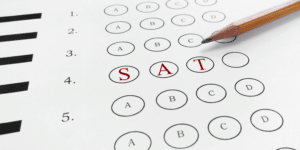The Secondary School Admissions Test is used for admission to private elementary, middle, and high schools throughout the United States. There are three levels of the test – Elementary, Middle, and Upper – each corresponding to one of the aforementioned three admissions processes. Each level of the test is taken by students across a range of ages, with the most common being the Upper Level taken by students applying into grades 9-12. Inspirica Pros’ approach to SSAT test prep starts with the fact that a student’s experience with the test will vary significantly depending on their age, which means that the optimal course of SSAT prep will vary as well. Your tutor will help determine the best way for your child to prepare and then use that plan to ensure that your child is in the best possible position going into test day.
SSAT Format
Each of the three levels of the SSAT is composed of an essay prompt and several multiple-choice sections that fall into one of three categories: Quantitative, Verbal, and Reading. The number, order, and length of the sections differ significantly between the three levels, however; visit the SSAT’s website for detailed information on the level of the test that your child will be taking.
The defining feature of the SSAT is the difficult blend of content knowledge and refined technique that it requires from test-takers. This is best seen in the Verbal section, where the analogy question-type combines challenging vocabulary with a question format that is unfamiliar to most students, making preparation twice as difficult. Don’t stress, though: our SSAT programs blend content and technique in whatever proportion is optimal for each individual student, so we’ll make sure that your child goes into test day as prepared as possible.
SSAT Scoring
First, your child’s raw score will be calculated for each of the three types of multiple-choice section on the SSAT. On the Elementary Level test, this score is simply equal to the number of questions your child answered correctly in that section; no penalty is applied for incorrect answers. On the Middle Level and Upper Level tests, however, a penalty of one-quarter point is deducted from for each incorrect answer.
Then, using a process called equating, the SSAT will produce a scaled score for each type of section; these scaled scores take into account the difficulty level of the sections that your child completed relative to the difficulty levels of sections that previous test-takers have completed.
Finally, the SSAT will compare your child’s scaled scores to those of previous test-takers and produce a percentile for each type of section, as well as an overall percentile. The essay is unscored and will simply be included as a timed writing sample if you choose to submit the score report for that test date to schools.
It is important to note that the scaled scores and percentile scores your child receives are calculated by comparing their results only to students of the same grade and gender. Because of this, an 8th grader does not need to get nearly as many questions correct on the Upper Level test as an 11th grader does in order to attain a given percentile score.
The SSAT itself does not superscore, or combine individual section scores from multiple test dates to obtain a maximum overall percentile; if you wish to send scores from multiple test dates to schools, you must send the entire score report from each test date. You can, however, pick and choose which test dates you send to schools through your account on the SSAT’s website.
Many schools will perform their own version of superscoring by combining the highest score for each section from the score reports that you submit in order to get a picture of your child’s “best” performance on the SSAT. For the most accurate information about how an individual school handles superscoring, be sure to contact that school’s admissions department directly.
SSAT Registration and Test Dates
The Middle and Upper Level tests are administered on six Standard test dates each year, while the Elementary Level test is administered on five of those dates. Standard testing is administered at official test centers, which are typically schools approved by the SSAT. You can search for the test center closest to you using the SSAT’s test center locator.
Additionally, all students are allowed to schedule up to two Flex test dates. Flex tests are typically administered at the offices of independent Educational Consultants rather than at schools and are therefore not bound by the same schedule as Standard tests. To register for a flex test date, you will need an access code which can only be obtained directly from the educational consultant with which you are scheduled to tests. You should therefore only register for a Flex test date after making your appointment with your EC.
There is no limit to the number of times a student can take the ML and UL SSAT, school application deadlines permitting, and it’s generally to your child’s advantage to test more than once. Part of beating any test is giving yourself as many opportunities as necessary to succeed, and taking the test multiple times can be a great way for your child to maximize their improvement.
To register for the SSAT, visit their site and follow the corresponding instructions. Testing accommodations must be approved prior to test registration and will expire during the summer following the testing season. Please note that it is the responsibility of a each family to provide the equipment, materials, and personnel necessary to support approved accommodations. For more information, please refer to the Testing Accommodation Guide for Students available through the SSAT website.
Get Started with SSAT Test Prep Today
To learn more about how we can help your child prepare for their SSAT, schedule a free consultation today!




